By Jim Hughes
I’d been looking for alternative lamp part numbers to use as landing and taxi lights, for our 1961 Cessna 175B, since we were replacing the landing light every few months, or so it seemed.
I don’t fly at night but I do run my taxi light during my flights for better visibility to other pilots. So, on with the search for something better, other than spending $100’s on LED landing lights.
However, there is now an Aero-lites ‘spot’ LED lamp that is $69, that will work ok as a taxi light:
https://www.amazon.com/Aero-Lites-LED-Landing-Light-Drop/dp/B01N7KJ128
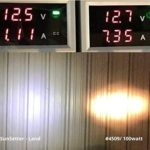 I’d only use it as a taxi light since the beam width is 15 degrees, vs a usual 9 degrees for a landing light. A comparison pic:
I’d only use it as a taxi light since the beam width is 15 degrees, vs a usual 9 degrees for a landing light. A comparison pic:
Note the narrow spot on the right for the 4509, and the much brighter, but wider beam for the LED.
They show them operating at 12.7 volts, but our normal voltage is 14.0-14.5 volts, so the 4509 current will be more like 8-9 amps. See more below on this.
So, for the ‘frugal’/ purist pilots:
The standard lamp is the GE 4509, which is specified as 100 watts at 13 volts and a life of 25 hours. The 25 hours part is very misleading, because our 12 volt aircraft actually run at 14.0 to 14.5 volts, assuming that your voltage regulator is set properly.
This higher voltage is necessary to fully recharge the battery after the 200-300 amps used to crank the engine to life. But that’s a whole different article!
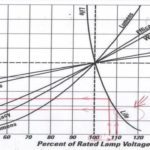 So, having worked on designs with indicator lamps as an engineer, I know that a 10 % increase in voltage will reduce the life of an incandescent lamp by 50% to 65%) see the graph, red lines).
So, having worked on designs with indicator lamps as an engineer, I know that a 10 % increase in voltage will reduce the life of an incandescent lamp by 50% to 65%) see the graph, red lines).
So, now our 25 hour bulb may only last 12.5 to as little as 9 hours…..that’s why they seem to burn out so often….they do.! Note, none of this applies to LED lamps, they will last a long time, as long as they don’t overheat
There must be something better that doesn’t cost the $250 to $300 that an LED landing light costs? And now $69 for a taxi LED lamp, as noted earlier.
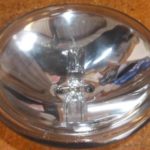 Well, there is! GE makes a quartz-halogen version, the Q4509. It looks a bit different, with a quartz bulb inside the sealed beam lamp shell…..it was probably an FAA thing. GE stopped selling it, but Martek and Galaxy both still make it.
Well, there is! GE makes a quartz-halogen version, the Q4509. It looks a bit different, with a quartz bulb inside the sealed beam lamp shell…..it was probably an FAA thing. GE stopped selling it, but Martek and Galaxy both still make it.
Some of the good things are that this lamp is rated at 100 hours, and since it’s a quartz –halogen, it is much less sensitive to applied voltage, so you can actually expect 100 hours from it… maybe more!
The current prices are about $15, so it’s only a few dollars more than the 4509. I like running the taxi light at all times when I’m moving; taxiing and flying, so I’d like more life.
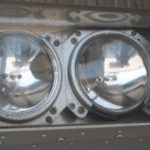 It turns out that the 4595 is a somewhat wider beam, and is rated at an amazing 300 hours!! ..really ? It’s still rated at 100 watts , but a little less beam power. But at $18 from Aircraft Spruce it’s a good choice. I’ve been using both of these in our Cessna since 2011….and the taxi light is still working after 300+ flight hours.
It turns out that the 4595 is a somewhat wider beam, and is rated at an amazing 300 hours!! ..really ? It’s still rated at 100 watts , but a little less beam power. But at $18 from Aircraft Spruce it’s a good choice. I’ve been using both of these in our Cessna since 2011….and the taxi light is still working after 300+ flight hours.
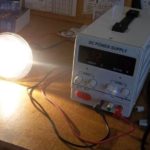 I did some bench testing of the 3 lamps, 4509, Q4509 and 4595, to determine applied volts, 13v and 14.2v,vs. amps, and compared the data to the GE specs, below.
I did some bench testing of the 3 lamps, 4509, Q4509 and 4595, to determine applied volts, 13v and 14.2v,vs. amps, and compared the data to the GE specs, below.
I quickly learned not to stand in the front of the beam.! There is a huge amount of IR within 3-4 feet in front of the lamp!
The comparison chart from GE at the end of this article, that I’ve marked up, has old costs from Aircraft Spruce, but the specs are still good.
The 4909Q is a quartz version, which is a higher power (125w vs 115w), longer life (100 hrs vs 25 hrs), and a little more expensive bulb.
The 4595 is a 100w , 300 hr bulb. It is really ideal for the taxi light since it is a wider beam than the 4509, 14 degrees wide, vs 12 degrees
It has lower power draw , measured at 7.0 amps vs 8.0 amps for the 4509, and long life , at the expense of a somewhat dimmer light.
The bench test data for the 3 bulbs at voltages of 13.0 and 14.2 volts, shows the actual power draw, vs The GE table that lists 100 watts for all three.
The 4509 is specified as a 100w bulb,
– at 14.2 volts (normal operating voltage), it draws 115w, or 8.0 amps.
– it is 100 w at the specified 13 volts , 7.6 amps, but no one operates it at this voltage
The 4509Q is also spec’d as 100w.
– at 14.2 v it is 125w , 8.8 amps
– it is 108w , 8.3amps at 13 volts.
– buy at Aircraft Spruce for $16
The 4595 is again spec’d as 100w.
– it is 100w at 14.2v , 7.0 amps.
– but is only 86w at 13v, 6.6 amps.
– also at Aircraft Spruce and Sky Geek, curently for $15
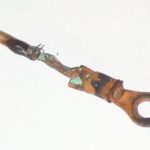 So there you have it: frugal choices in landing lights!
So there you have it: frugal choices in landing lights!
PS, make sure that all of the connections are tight and secured. This landing light switch connection was loose and overheated, melting all of the insulation on the terminal and an inch of the wire, and could have caused a fire!

